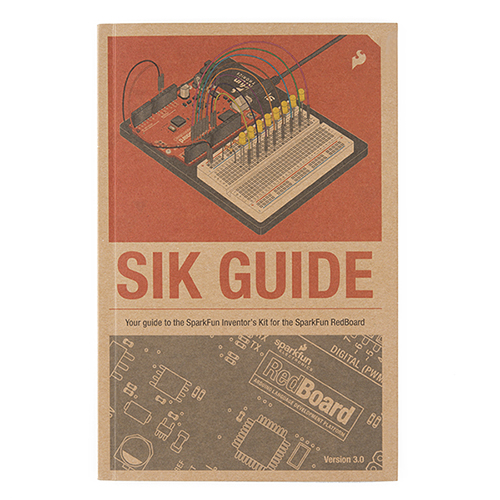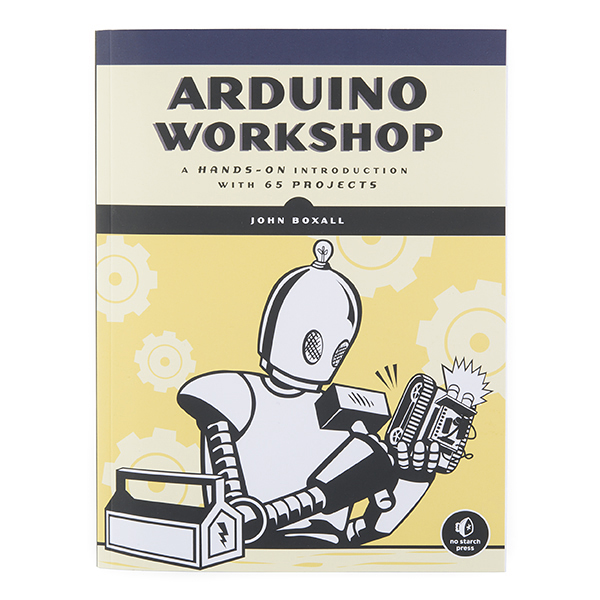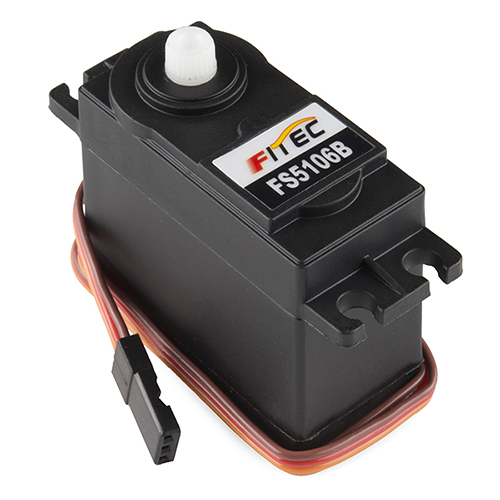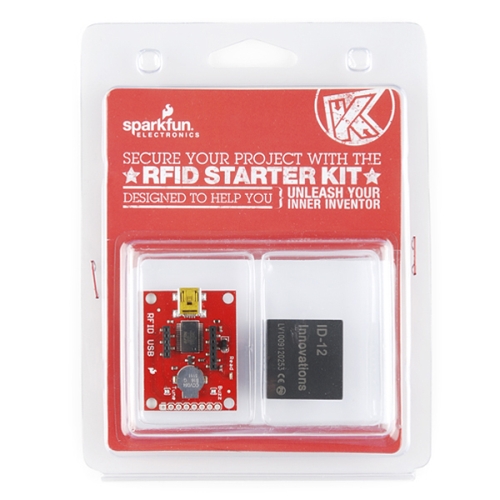Welcome back to another Friday at SparkFun. It's like Christmas every week! This week we have some books o' knowledge and some electricity boards. Check 'em out.
ReplaceMeOpen
ReplaceMeClose
The Internet has a wealth of information, but sometimes a book is a great resource too. Structured learning (like working through specific projects) can be a fantastic way to give you a solid foundation.
The SIK guide is at the heart of the SparkFun Inventor's Kit. The guide starts you off by explaining what an Arduino is, why you care, and how to get started. It moves you through 15 progressively more complex circuits to give you a familiarity with Arduino and programming. It's a great place to start out. If you don't want to purchase the entire SIK, you can purchase the guide separately and scrounge up your own parts. Or, we offer the guide as a PDF if you just want a digital copy.
As I said above in the video, sometimes you might want a more comprehensive resource for Arduino. We carry MANY books on Arduino, and we carry each one for a reason. The Arduino Workshop is our newest book and it approaches Arduino through numerous examples and projects. If you learn better by actually DOING a project rather than reading about it, this is a good book for you.
We have another servo motor this week. This one is a standard-sized servo motor. If you're looking for a basic servo for testing, these are really nice. They have a decent amount of power, come with a good selection of accessories, and are relatively inexpensive. Sometimes you just need a basic motor to test out your design.
You're not always starting from scratch; sometimes you need to interface with existing hardware. I tend to hack on existing stuff quite a bit, and you never know what you'll run into. If you run into either an RS232 or RS485 system that you need to mess with, check out either of these two new shields from LinkSprite. They come in two different versions, the RS232 shield and the RS485 shield which communicate with their respective namesakes. They just tap into the TX and RX line of the Arduino and translate it into their respective protocols.
Who said you can't have fun with an FPGA? Well, a lot of people probably. The RetroCade MegaWing turns your Papilio Pro into a cool MIDI device. It has MIDI inputs, outputs and a passthrough. It also has a microSD card slot, joystick, 16x2 LCD, and more.
Lastly, we have a new version of the RFID Starter Kit. The ID-20 was discontinued and replaced with the ID-20LA, so the kit got an update. The kit includes the ID-20LA, RFID USB reader, and a couple RFID cards.
That's all I have for this week. Next week we have a cool new robotic product, so be sure to check back if that's your thing. Thanks for reading and see you next week!












I am still waiting for a noob FPGA tutorial D:!
Here are two free online tutorials from Altera. I do not work for Altera, but I am interested in the material you would like to be covered. These are basic and cover what is an FPGA and how to do a first design. Please let me know what other information you would like to learn for newbie designers to FPGA. I am trying to put together some tutorials and training for hobby folks.
http://www.altera.com/education/training/courses/ODSW1005 You will be able to: Describe the technologies that make up modern CPLD and FPGA devices Understand how programmable logic devices are programmed Understand the differences between CPLD and FPGA devices Choose the right device technology for a design
and
http://www.altera.com/education/training/courses/ODSW1010 You will be able to: Understand the benefits and advantages to including FPGAs in your system designs Start a new FPGA design in the Quartus II Software Create a schematic using the schematic editor Convert HDL files into schematic symbols Create basic pin and timing constraints Compile a design and program an FPGA
Although nice, these tutorials are really kind of designed for someone who has knowledge and background in logic design and FPGA development.
Not only that, but Sparkfun sells mostly Xilinx Spartan6 devices (Papilio Pro, Mojo v3).
I recommend looking at Hamster (Hamsterworks) for FPGA tutorials: http://hamsterworks.co.nz/mediawiki/index.php/FPGA_course
"Although nice, these tutorials are really kind of designed for someone who has knowledge and background in logic design and FPGA development."
This statement doesn't make sense to me. You SHOULD have some knowledge and background in logic design before attempting to program FPGA's. In fact, at the bottom of the wikipedia link you placed there is a section that describes the prerequisites. On there are Boolean operators AND, OR, NOT, and XOR. They also suggest a familiarity with low level languages like C or C++. I concur with those prerequisites.
Altera has some other tutorial as well, found in their University Program section: http://www.altera.com/education/univ/unv-index.html
The section on Embedded design allows you to download a pre-built SOC (system on a chip) to an FPGA and program in C/C++. You still need to learn C/C++ programming on your own, but this makes it easier to access the hardware on their development boards.
If you want to program an FPGA using VHDL, Verilog, or schematic design, you really do have to learn digital logic first. It is hardware that you are creating and you have to explicitly know quite a bit more about the logic behind.
This does pose an interesting challenge. It depends on what you want to accomplish with the FPGA. Do you want to learn how to build your own micro-controller? or do you want the underlying hardware libraries in place to interface with other sensors? If so, why use an FPGA?
P.S. Thanks for posting the hamsterworks FPGA tutorials. Nice resource.
Fair enough, Thanks.
Bool·e·an [boo-lee-uhn]
Are there any plans/thoughts towards carrying the "HE" modules from ID Innovations? They are able to read both EM and HID card types, which is awesome for those of us with HID-type cards that we use at work, and who like the much cheaper unit price of EM clones.
The word "secure" and 125 KHz RFID do not mix.
It is totally insecure, prone to cloning.
EM4100 and it's variants: Yes.
But T5557 is sweet: http://www.priority1design.com.au/t5557_rfid_transponder.html [Note the password feature.]
T55x7-type cards are susceptible to cloning.
References:
They are useful to perform closing, yes, but I was referring to not being (easily) able to clone a password protected T5557 card. None of your references were going after that scenario unless I missed something.
With the password protection mode enabled the card will not send the data from a password protected block until it has received the password from the scanner. It can also be configured to require a password to be sent to the card before any data on the card can be changed. So while its still easy to replicate the data, you first have to know the data and that can be a bit trickier. (Card sends initial unprotected data block, system looks up card-specific password, sends password to card, card responds with protected block, system reprograms protected data block and password just for good measure.)
I see. I thought the password just prevented unauthorized writing.
Its a great post, as well as a great product, thanks for posting this.
RN-52!
Does the RFID kit have the ID-20LA or the ID-12LA?
The RFID kit now has the ID-12LA. It looks like there is a typo on this page, but I assure you the kit has a 12LA, not a 20LA. :)